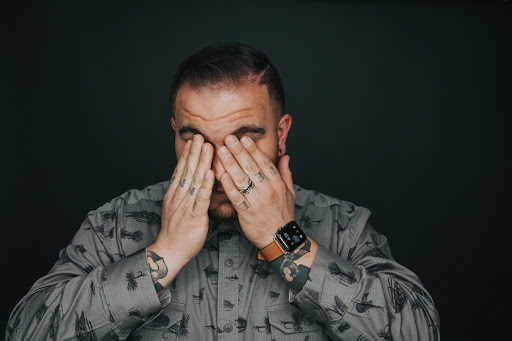Computer Vision Syndrome & Digital Eye Strain
Growing up, your parents probably told you (over and
over and over again) not to sit too close to the TV… turns out that they
weren’t very far off-base with their parental guidance. It was just
assumed, back then, that whatever was coming out of screens wasn’t
necessarily good for little eyeballs.
Now that we’re adults (thanks to the access we have to the devices we all carry in our pockets every day) digital screens are just inches away from our faces- and our eyes are not loving it.
Even though the human body does amazing things every day, and is highly adaptable- our eyes were never meant to stare at screens for long periods of time, or endure this much exposure to artificial light. With the average American spending most of their waking hours looking at some sort of digital screen- we’re bound to start seeing some issues where our vision is concerned.
The discomfort that so many people experience after staring at their computer screen is most likely due to something called Digital Eye Strain (DES, for short) or Computer Vision Syndrome (CVS, also for short).
Recently, The Vision Council discovered that about 60% of people who use their computers or other digital devices daily will experience one or more of the unfortunate symptoms associated with digital eye strain, or computer vision syndrome.

Every single one of the devices that we use (in most cases on a daily base) emits some amount of blue light rays, which we’ll dive into in a minute.
When you’re working on a computer or tablet, your eyes are constantly focusing and refocusing. This requires a massive amount of effort for your eyes- and to make matters worse; unlike a book or piece of paper, the screen adds contrast, flicker, and glare. While there’s no proof that computer use will cause long-term damage to the eyes, regular exposure to computer screens can definitely lead to eye strain and discomfort.
There are several symptoms you can expect to experience if you’ve been diagnosed with digital eye strain or computer vision syndrome.
Here are the most common symptoms, according to the American Optometric Association:

Despite what you may read in recent news: blue light is not the devil.
In fact, it’s been proven that a little blue light exposure is actually crucial for your health and wellness. Research shows that high-energy visible light (*ahem blue light*) can boost alertness, help with memory and cognitive function, and even elevate your overall mood.
That being said- even good things need to be used in moderation.
Ten or twenty years ago, computer screens didn’t produce as much blue-light, and people didn’t have access to screens like we do today- so, blue light exposure wasn’t as much of a problem as it’s starting to pose today.
Blue light is damaging to your eyes because- unlike other UV rays that are blocked by the cornea and the lens- pretty much all blue-light passes through/goes straight to the retina, causing damage that can lead to degenerative conditions, and in some cases- vision loss.
Additionally, blue light suppresses your body’s melatonin secretion, which is what helps you fall asleep at night. A Harvard Medical School study found that blue light exposure at night suppressed melatonin production for about twice as long as green light, and altered circadian rhythms by twice as much! That’s why experts advise users to stay off their phones (or computers) for at least 2 hours prior to going to sleep.
You don’t snooze, you lose…

If you have CVS, your eye care professional will help you come up with a plan of action and ways to prevent this from happening in the future. According to the American Optometric Association, testing for computer vision syndrome or digital eye strain may include:
Luckily, there are many measures you can take to avoid digital eye strain and computer vision syndrome. Here are a few actionable, practical ways of combating this common problem:

Follow the “20-20-20 Rule”
Another great way of protecting your eyes from digital eye strain or computer vision syndrome is by following the 20/20/20 rule; every 20 minutes, take a 20 second break, and look 20 feet away.
This is the first line of defense against eye strain, and is highly recommended by optometrists and eye doctors for people interested in avoiding eye complications associated with computer use. This reduces stress on your eyes, and can combat the negative effects of digital screen.
Practice Better Computer Habits:
Do you know how much time you personally spend in front of a screen each day? If you tracked the actual time, you might be alarmed; a small study found that, on average, Americans spend about five hours a day, on just their phone alone. Here’s your wake-up call…
If you work on a computer during the day, and then come home and watch netflix before bed while scrolling on Instagram- all of this adds up to a significant amount of time in front of a screen, exposed to artificial blue light. It’s time to switch-up your daily routine!
It’s incredibly important to make a habit out of taking a 2-3 minute “digital screen break”- every 20 minutes or so. Also, most phones and tablets have specific settings that you can turn on at night, to lower the blue light emission. So make sure that when night rolls around, you either put your phone away for the night, or protect your eyes with a pair of blue light blocking glasses.
Haven’t heard of these yet? Click here for a comprehensive guide on blue light blocking glasses, or keep reading…
Wear a Pair of Blue-Light Blocking Glasses
Blue-light blocking glasses are made specifically to block out the blue-light emanating from your digital devices. By wearing these glasses at work or while you binge-watch your favorite shows at night, you are protecting your eyes from the high-energy light, and helping your body stay on a normal sleep-cycle.
Eat Natural Foods to Help Promote Better Vision
Most of the time, people attribute their failing eyesight to factors like age or strain from computer use. The reality is (just like with so many other bodily functions) maintaining a healthy diet is crucial for the health of your eyes!
Eating foods that are high in vitamins, nutrients and antioxidants (like lutein and zeaxanthin) will strengthen and support your eye health- especially after long periods of digital screen time and exposure to blue light.
If you’re still worried about your exposure to blue light, or the strain it might be putting on your vision, consider talking to one of the experts here at LasikPlus.
Our trained eye care specialists will be able to evaluate your eye health, and talk to you about some additional options for improvement, such as getting LASIK to help you achieve 20/20 vision without needing glasses!
Schedule a free consultation today online, or call us at +91 8080 713 636
What’s better than seeing your world more clearly?
Now that we’re adults (thanks to the access we have to the devices we all carry in our pockets every day) digital screens are just inches away from our faces- and our eyes are not loving it.
Even though the human body does amazing things every day, and is highly adaptable- our eyes were never meant to stare at screens for long periods of time, or endure this much exposure to artificial light. With the average American spending most of their waking hours looking at some sort of digital screen- we’re bound to start seeing some issues where our vision is concerned.
The discomfort that so many people experience after staring at their computer screen is most likely due to something called Digital Eye Strain (DES, for short) or Computer Vision Syndrome (CVS, also for short).
Recently, The Vision Council discovered that about 60% of people who use their computers or other digital devices daily will experience one or more of the unfortunate symptoms associated with digital eye strain, or computer vision syndrome.

Explaining Digital Eye Strain or Computer Vision Syndrome
Simply put, the terms “digital eye strain” and “computer vision syndrome” are used to describe the group of issues associated with prolonged exposure to digital devices; whether that’s from your cell phone, tablet, laptop, gaming device or TV screen.Every single one of the devices that we use (in most cases on a daily base) emits some amount of blue light rays, which we’ll dive into in a minute.
When you’re working on a computer or tablet, your eyes are constantly focusing and refocusing. This requires a massive amount of effort for your eyes- and to make matters worse; unlike a book or piece of paper, the screen adds contrast, flicker, and glare. While there’s no proof that computer use will cause long-term damage to the eyes, regular exposure to computer screens can definitely lead to eye strain and discomfort.
There are several symptoms you can expect to experience if you’ve been diagnosed with digital eye strain or computer vision syndrome.
Here are the most common symptoms, according to the American Optometric Association:
- eyestrain
- headaches
- blurry vision
- dry eyes
- red eyes
- neck & shoulder pain

What is Blue Light?
Blue Light is a high-energy light, that is emitted by all digital devices. Blue light is way up there on the top of the visible light spectrum- close to UV light. Blue light is a short wavelength, which means it produces higher amounts of energy- and it’s because of this that blue light is also referred to as high energy visible light (or HEV). Visible light is determined by how long the wavelengths are and how much energy is produced. The longer the wavelength, the less amount of energy is produced (safer) and the shorter the wavelength, the more energy is produced (making it potentially dangerous).Despite what you may read in recent news: blue light is not the devil.
In fact, it’s been proven that a little blue light exposure is actually crucial for your health and wellness. Research shows that high-energy visible light (*ahem blue light*) can boost alertness, help with memory and cognitive function, and even elevate your overall mood.
That being said- even good things need to be used in moderation.
Ten or twenty years ago, computer screens didn’t produce as much blue-light, and people didn’t have access to screens like we do today- so, blue light exposure wasn’t as much of a problem as it’s starting to pose today.
Blue light is damaging to your eyes because- unlike other UV rays that are blocked by the cornea and the lens- pretty much all blue-light passes through/goes straight to the retina, causing damage that can lead to degenerative conditions, and in some cases- vision loss.
Additionally, blue light suppresses your body’s melatonin secretion, which is what helps you fall asleep at night. A Harvard Medical School study found that blue light exposure at night suppressed melatonin production for about twice as long as green light, and altered circadian rhythms by twice as much! That’s why experts advise users to stay off their phones (or computers) for at least 2 hours prior to going to sleep.
You don’t snooze, you lose…

How is Digital Eye Strain or Computer Vision Syndrome Diagnosed?
Digital eye strain and computer vision syndrome can be diagnosed with a basic, comprehensive eye exam.If you have CVS, your eye care professional will help you come up with a plan of action and ways to prevent this from happening in the future. According to the American Optometric Association, testing for computer vision syndrome or digital eye strain may include:
- Patient history: to determine any symptoms the patient is experiencing and the presence of any general health problems, medications taken, or environmental factors that may be contributing to the symptoms related to computer use.
- Visual Acuity Measurements: to assess the extent to which vision may be affected.
- Refraction: to determine the appropriate lens power needed to compensate for any refractive errors (nearsightedness, farsightedness or astigmatism).
- Testing how the eyes focus, move and work together: in order to obtain a clear, single image of what is being viewed, the eyes must effectively change focus, move and work in unison. This testing will look for problems that keep your eyes from focusing effectively or make it difficult to use both eyes together.
How to Avoid Digital Eye Strain or Computer Vision Syndrome
If you are experiencing DES or CVS, or you’re simply looking for ways to avoid these issues, talk to your optometrist as soon as possible.Luckily, there are many measures you can take to avoid digital eye strain and computer vision syndrome. Here are a few actionable, practical ways of combating this common problem:

Follow the “20-20-20 Rule”
Another great way of protecting your eyes from digital eye strain or computer vision syndrome is by following the 20/20/20 rule; every 20 minutes, take a 20 second break, and look 20 feet away.
This is the first line of defense against eye strain, and is highly recommended by optometrists and eye doctors for people interested in avoiding eye complications associated with computer use. This reduces stress on your eyes, and can combat the negative effects of digital screen.
Practice Better Computer Habits:
Do you know how much time you personally spend in front of a screen each day? If you tracked the actual time, you might be alarmed; a small study found that, on average, Americans spend about five hours a day, on just their phone alone. Here’s your wake-up call…
If you work on a computer during the day, and then come home and watch netflix before bed while scrolling on Instagram- all of this adds up to a significant amount of time in front of a screen, exposed to artificial blue light. It’s time to switch-up your daily routine!
It’s incredibly important to make a habit out of taking a 2-3 minute “digital screen break”- every 20 minutes or so. Also, most phones and tablets have specific settings that you can turn on at night, to lower the blue light emission. So make sure that when night rolls around, you either put your phone away for the night, or protect your eyes with a pair of blue light blocking glasses.
Haven’t heard of these yet? Click here for a comprehensive guide on blue light blocking glasses, or keep reading…
Wear a Pair of Blue-Light Blocking Glasses
Blue-light blocking glasses are made specifically to block out the blue-light emanating from your digital devices. By wearing these glasses at work or while you binge-watch your favorite shows at night, you are protecting your eyes from the high-energy light, and helping your body stay on a normal sleep-cycle.
Eat Natural Foods to Help Promote Better Vision
Most of the time, people attribute their failing eyesight to factors like age or strain from computer use. The reality is (just like with so many other bodily functions) maintaining a healthy diet is crucial for the health of your eyes!
Eating foods that are high in vitamins, nutrients and antioxidants (like lutein and zeaxanthin) will strengthen and support your eye health- especially after long periods of digital screen time and exposure to blue light.

The Best Decision for Your Eyes
While it’s virtually impossible to avoid all blue light exposure in today’s modern world, by incorporating some of the simple tips mentioned into your daily routine, you can help protect your precious peepers from the irreversible damage of blue light exposure.If you’re still worried about your exposure to blue light, or the strain it might be putting on your vision, consider talking to one of the experts here at LasikPlus.
Our trained eye care specialists will be able to evaluate your eye health, and talk to you about some additional options for improvement, such as getting LASIK to help you achieve 20/20 vision without needing glasses!
Schedule a free consultation today online, or call us at +91 8080 713 636
What’s better than seeing your world more clearly?

Comments
Post a Comment